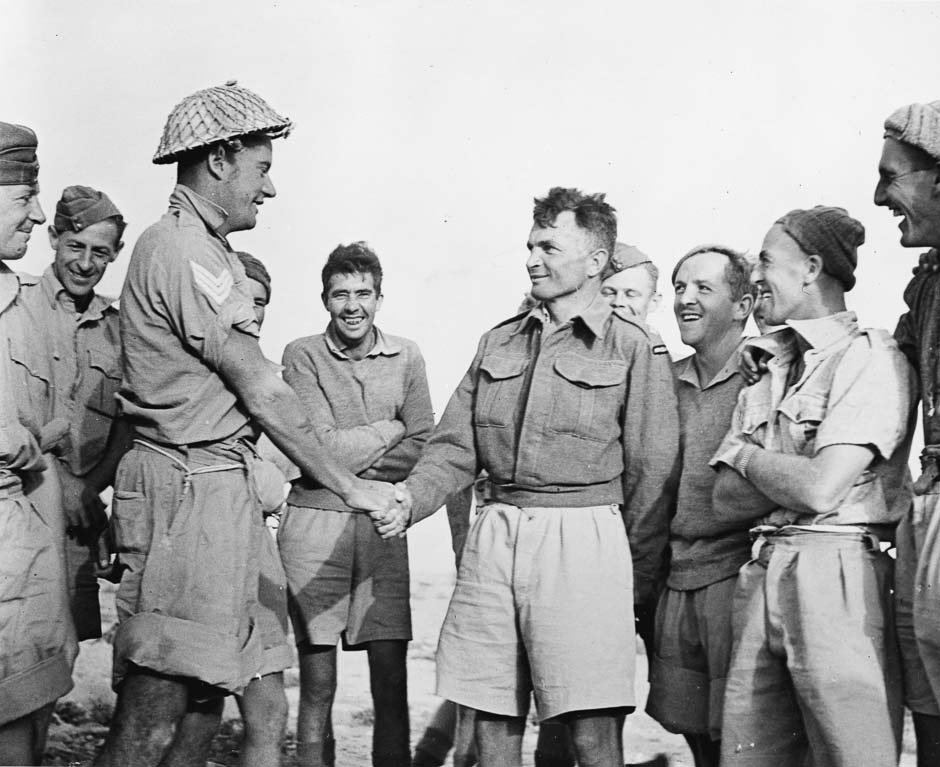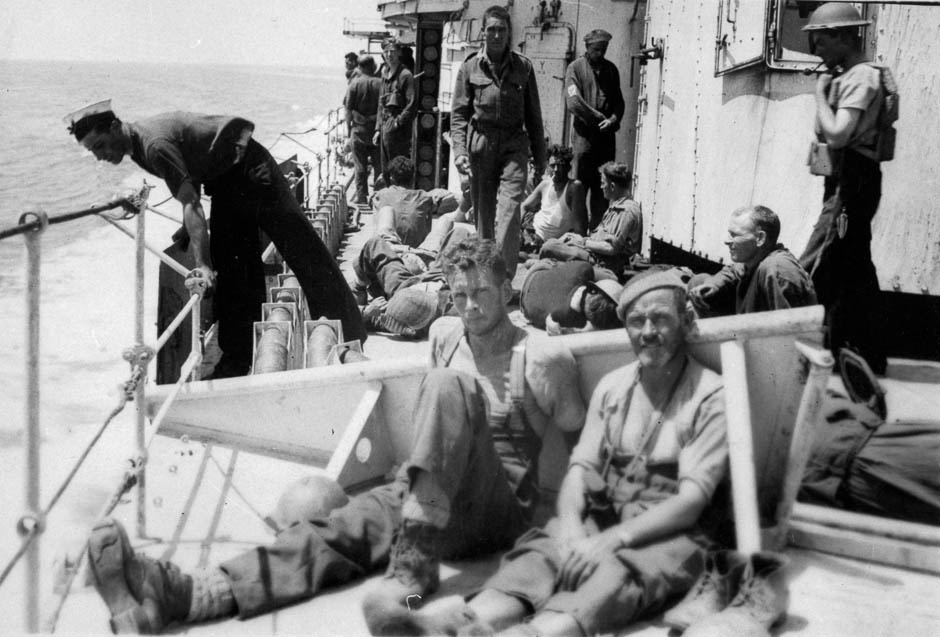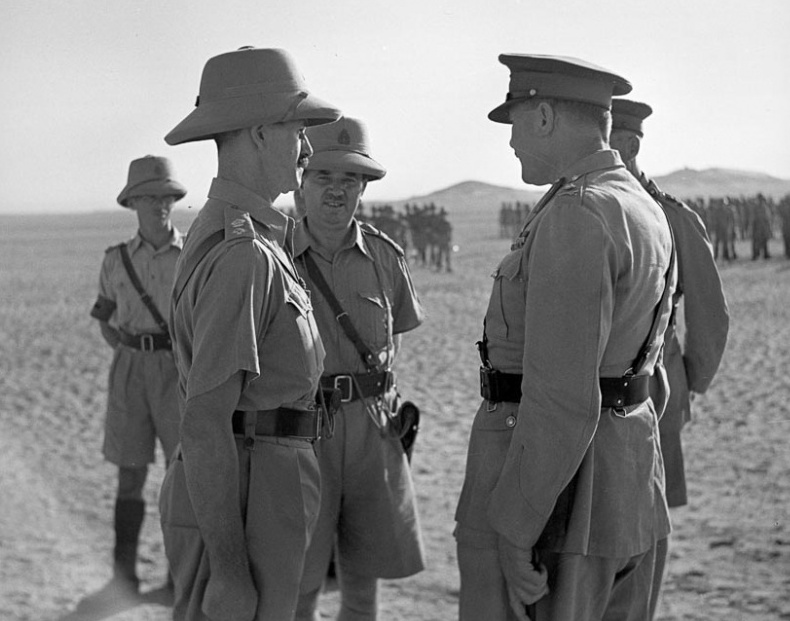The cost of the Battle for Crete
Day eleven – 30 May 1941: who leaves, who stays?
A rearguard force positioned above the beaches held off repeated German attacks. Evacuation plans had to be scaled down as some of the ships were forced back to Egypt. Tensions rose as decisions were made as to which soldiers should go first.
Rearguard actions
The Germans pushed closer to Sfakia. Troops from 100th Mountain Regiment followed up the New Zealand withdrawal during the night and occupied the Askifou Plain. As the Germans moved south they came into contact with rearguard forces. By dusk they had battled to within sight of the village of Imvros – about 16 km from Sfakia. Here they found an Australian battalion – 2/7th Battalion – blocking the road. In an attempt to outflank the Australians the German commander sent his troops into two ravines on either side of the road.
In the western Sfakiano Ravine the advancing mountain troops ran into elements of 20th Battalion, which was now led by Colonel Howard Kippenberger. To block the ravine Kippenberger sent one of his companies – including Second Lieutenant Charles Upham’s platoon – to occupy high ground on one side. As Kippenberger recalled:
Upham’s platoon was slowly climbing up the steep 600-foot hill west of the ravine.… Two hours after they had started the climb there was another sharp outburst of firing.… A little later Upham’s platoon started to come back and then a message came that all twenty-two of the enemy party had been killed, completely helpless under his plunging fire.
For this and earlier actions on Crete Upham was awarded the Victoria Cross (VC).
Tough decisions
At Creforce HQ Freyberg and his commanders deliberated over that night’s evacuation. Each of the four destroyers due to arrive after dark would take 500 men. Both 4th and 5th Brigades were selected to go, but there was not room on the ships for all of 5th Brigade. Brigadier James Hargest reluctantly chose 21st Battalion to stay behind. Another New Zealand unit, 18th Battalion, was ordered to form a perimeter around the beach to make sure that the evacuation was orderly.
Later that day news arrived from Alexandria that the evacuation was to be scaled back. Only 250 men were to be taken on each destroyer because the ships would be exposed to air attacks next day and the risk of casualties on crowded vessels was too great. The reduction in numbers meant that 5th Brigade would be staying another night.
More bad news was to come. Only two destroyers arrived to continue the evacuation; mechanical faults and bomb damage had forced two others to turn back. Despite the lack of space, 1400 men were taken off that night. The entire 4th Brigade embarked behind an armed cordon put in place to prevent desperate stragglers from rushing the ships. Colonel Kippenberger, who led 20th Battalion down to the beach that night, described the feelings of those going:
The afternoon wore miserably on, but at last there was nothing for it but to say good-bye and go. … We had a tramp of some miles to the beach, the last part lined with men who had lost their units and were hoping for a place with us. Some begged and implored, most simply watched stonily, so that we felt bitterly ashamed. There was a cordon around the beach with orders to shoot any man who tried to break in. I had to count my men through. We were the last unit to pass….
Colonel Howard Kippenberger, 20th Battalion, in D.M. Davin, Crete, 1953, p. 435
During the night Sunderland flying boats arrived to take Freyberg and other senior staff officers back to Egypt.
Day twelve – 31 May 1941: the last night of the evacuation
More than half the remaining members of Creforce were evacuated from Sfakia. Lack of space on ships combined with a scarcity of supplies meant that 6500 troops – including 2100 New Zealanders – were left behind on Crete to face inevitable capture by the Germans.
Last chance for evacuation
At dawn on 31 May there were still some 9000 men in and around Sfakia waiting to be evacuated. Time was fast running out. General Wavell, conscious of mounting naval and troop losses, decided that the evacuation that night would be the last. Four destroyers were initially allocated to this operation. When the New Zealand Prime Minister Peter Fraser, who was in Egypt, learned that 31 May was to be the final night of the evacuation, he urged Admiral Sir Andrew Cunningham, Commander-in-Chief of the Mediterranean Fleet, to send an additional ship. The loss of men on Crete would be a crushing blow to New Zealand’s war effort, Fraser argued. Cunningham’s response was to order that the cruiser HMS Phoebe return to Crete.
Back at Sfakia news had filtered through that this would be the final night of evacuation. With room only for an estimated 3500 men, priority was given to infantry units – including 5th Brigade, 19th Brigade and a British Royal Marine battalion. By the time the ships left around 4000 troops had been squeezed on board, including 80 walking wounded. Those leaving did so with mixed feelings, their relief at getting off the island tempered with regret for those left behind.
Creforce surrenders
On the morning of 1 June 1941, the 5000 Allied troops left at Sfakia realised that they had been abandoned. Their trek over the mountains of Crete had been for nothing. Bewildered and angry, they now faced the prospect of captivity.
We reached some caves at Sfakia and hid in these caves. Then one of the officers told us to pile up our weapons and wait for the Germans – we were aghast, and cursed all and sundry. Then the Germans arrived and started marching us back over the mountains. There was no food or drink and the Germans robbed us of watches and rings on the march to the POW camp. It was a bloody shambles.
Signalman Peter Cosgrave, Divisional Signals, in M. Hutching (ed.) ‘A unique sort of battle’: New Zealanders remember Crete, 2001, p. 202
During the morning of 1 June the exhausted remnants of Creforce formally surrendered to the Germans and began a depressing march back across the mountains. With others captured elsewhere on the island, 6500 Commonwealth troops went ‘into the bag’. Among them were 2100 New Zealanders – the largest number of New Zealand prisoners of war (POWs) taken in a single battle during the Second World War.
Prisoners of war
Those captured on Crete were initially held at a transit camp near Galatas before being transported to mainland Greece. Conditions at the overcrowded camp were poor; food shortages, lack of medical supplies and primitive sanitation added to the depression of the POWs. Private Colin Burn, 18th Battalion, described how the lack of basic facilities at the Galatas camp contributed to an outbreak of disease amongst prisoners:
The conditions in the camp were shocking. It was dusty and dirty and there was only sandy ground, with a few tufts of grass. The toilet facilities were shocking. All they had was a trench in the ground, dug in on the outside, the edge of the camp. Out in the open. Everyone had dysentery. It was nothing to see a hundred all lined up along the trench, and more waiting to get there. Chaps couldn’t make it. If you soiled your clothes, all you could do was go down to the beach and get in the tide. There was only one well, and the water used to get muddy in that.
Private Colin Burn, 18th Battalion, in M. Hutching (ed.) ‘A unique sort of battle’: New Zealanders remember Crete, 2001, p. 199
On the mainland, the POWs joined those captured in Greece in transit camps at Corinth or Salonika. From here they were taken north by train. Officers and non-commissioned officers went to Germany, while the rest ended up in camps in Austria and northern Yugoslavia (modern-day Slovenia). There most of them stayed until they were liberated in 1945.
Escapees
Others were not content to sit out the war in captivity. Many men took advantage of the relatively lax security at the transit camp near Galatas and took to the hills. They were helped, at great personal risk, by the Cretan people. Some soldiers roamed Crete for several years trying to find a way off the island. Others managed to escape on boats or submarines. A few made it to neutral Turkey via Greece or went directly to Egypt. One of these men was Second Lieutenant Walter ‘Sandy’ Thomas. Wounded and captured on Crete, he escaped from a transit camp in Greece and reached Turkey after sheltering with monks on Mt Athos.
Other escapees became involved in the guerilla war waged by Cretan resistance groups against the German–Italian occupation force. Among them were New Zealanders Staff Sergeant Tom Moir and Sergeant Dudley Perkins – escaped POWs who returned to Crete with the Special Operations Executive. Perkins, known as ‘Vasili’ to Cretan partisans, went on to earn the moniker ‘Lion of Crete’ for his exploits with resistance groups. He was killed in action in February 1944.
The cost
The cost of the Battle for Crete was high for both sides. Total casualties among Commonwealth forces were 15,743, of whom 1751 were killed or died of wounds. Of the 7700 New Zealanders involved in the battle, 671 were killed – a fatality rate of nearly 9% – while another 2180 were taken prisoner. In naval operations around Crete the Royal Navy lost three cruisers, six destroyers and the lives of more than 2000 sailors.
German losses were very heavy. More than 3000 died during the battle and a similar number were wounded. Crete would prove to be, as General Kurt Student later commented, the ‘graveyard of the paratroops’. They were never again used in a large-scale airborne offensive.
People have argued about the Battle for Crete since it occurred. The Allied forces on the island knew of the enemy’s intentions and had the chance to inflict a humiliating defeat on the Germans – the first they would have suffered on land during the war. Who was responsible for the mistakes that allowed the Germans to gain control of the vital airfield at Maleme and hold it against subsequent counter-attacks?
Mistakes at Maleme
There is debate about the officers responsible for operations in the Maleme sector. The actions of Lieutenant-Colonel Leslie Andrew VC, the commander of 22nd Battalion in the crucial positions dominating the airfield, have come under question; some think he may have lost his nerve. Andrew’s decision to pull back off Hill 107 during the night of 20–21 May 1941 opened the way for the Germans to occupy it without opposition on the morning of the 21st. Assuming incorrectly that two of his companies on the edge of the airfield had been overrun, Andrew decided to pull back to defensive positions before daylight, when the Luftwaffe (German air force) would make such a manoeuvre too dangerous.
The commanders of the neighbouring battalions, Lieutenant-Colonels J.M. Allen (21st Battalion) and D.F. Leckie (23rd Battalion), have also been criticised for failing to carry out their pre-invasion orders: to counter-attack immediately if the Germans secured a lodgement on the airfield. A failure to perceive the danger, some uncertainty in the pre-invasion orders and the lack of drive exhibited by their superior ensured that neither battalion intervened to assist 22nd Battalion. But the suggestion by historian Tony Simpson that Leckie had a nervous breakdown on the first morning which accounts for 23rd Battalion’s failure to go to 22nd’s assistance can be discounted. Although Simpson’s claim was based on the recollection of an officer of the battalion, several others who were present have strongly rejected any suggestion that Leckie was incapacitated. Instead, they have pointed to the orders he received from his superior, Brigadier James Hargest, 5th (NZ) Brigade’s commander.
Hargest has come under most scrutiny. His lethargy and lack of judgement during the first two days of the battle placed a spotlight on how he came to be serving with the 2nd New Zealand Expeditionary Force (2NZEF). In 1939 he had been found unfit for overseas service but had secured a commission through his political connections as a Member of Parliament. Hargest accepted Andrew’s plans to pull back from Hill 107 during the 20th – ‘If you must, you must’ – and led Leckie and Allen to believe that 22nd Battalion was holding its own at Maleme without the need for assistance. The fact that he remained at his headquarters, well removed from the scene of action, has also been criticised.
Controversy also surrounds the actions of the temporary commander of the 2nd New Zealand Division, Brigadier Edward Puttick. His failure to order a counter-attack on the German concentration in the Prison Valley on the 20th was perhaps his biggest tactical error of the campaign. He was reluctant to commit his reserves because of a fear of a further airborne landing, but more especially because of the perceived threat from the sea. He too failed to grasp the situation on the first day and ensure a more aggressive response on Hargest’s part.
Freyberg’s leadership
Creforce commander Major-General Bernard Freyberg has also been the subject of considerable criticism. As overall commander of the Allied forces on Crete, he must take responsibility for the failure. His performance was criticised at the time by several of his subordinates. Hargest, for example, complained to Prime Minister Peter Fraser that Freyberg did not ‘keep control over the conduct of operations’, failed to take his senior officers into his confidence and occasionally left doubts as to his intentions.
Brigadier Lindsay Inglis, commander of 4th (NZ) Brigade, also raised doubts about Freyberg’s conduct of the battle at a meeting with British Prime Minister Winston Churchill in London shortly afterwards. These contemporary criticisms have been echoed more recently by several British historians (Antony Beevor, Callum MacDonald) in light of revelations of the ULTRA intelligence available to Freyberg. They accuse him of muddled thinking and of making a key mistake on 21 May based on a misreading of an ULTRA signal. This, they argued, led to the counter-attack by 28th (Maori) and 20th Battalions being fatally delayed on Freyberg’s orders because he expected an imminent seaborne attack.
Freyberg made serious tactical errors in both his dispositions (especially leaving the area west of the Tavronitis River unguarded) and his response to the invasion. But the ULTRA argument is too simplistic as an explanation for the failure of the crucial counter-attack. Even if that attack was delayed by Freyberg, there can be no certainty it would have succeeded if it had gone ahead at the earlier time planned – given that it was in two-battalion strength only and the Germans at the airfield had been reinforced by fresh troops the previous day.
Continue reading.
Source: http://www.nzhistory.net.nz/war/the-battle-for-crete












